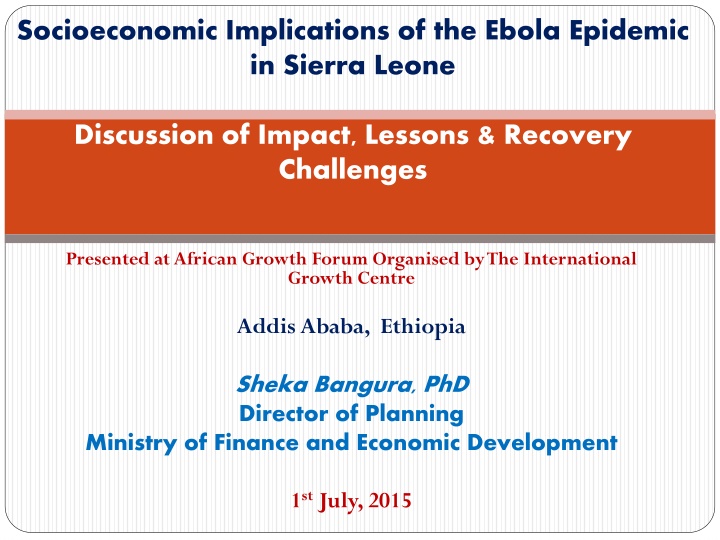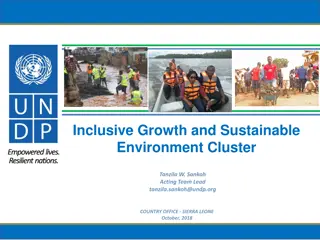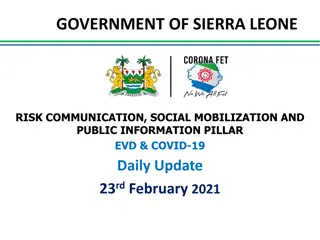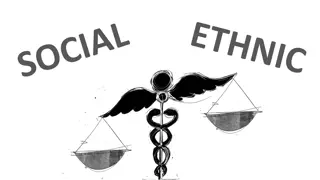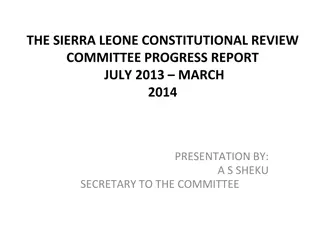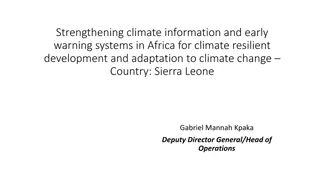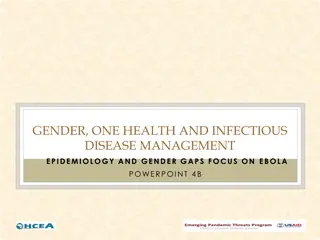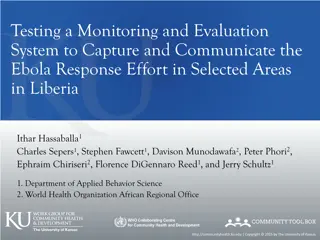Socioeconomic Implications of the Ebola Epidemic in Sierra Leone: Discussion of Impact
The Ebola epidemic in Sierra Leone led to a devastating impact on the economy, exacerbating existing vulnerabilities and dampening prospects of achieving Vision 2035. This presentation discusses the background, economic status pre-Ebola, lessons learned, recovery strategy, and immediate priorities for building national resilience.
Uploaded on Feb 18, 2025 | 0 Views
Download Presentation

Please find below an Image/Link to download the presentation.
The content on the website is provided AS IS for your information and personal use only. It may not be sold, licensed, or shared on other websites without obtaining consent from the author.If you encounter any issues during the download, it is possible that the publisher has removed the file from their server.
You are allowed to download the files provided on this website for personal or commercial use, subject to the condition that they are used lawfully. All files are the property of their respective owners.
The content on the website is provided AS IS for your information and personal use only. It may not be sold, licensed, or shared on other websites without obtaining consent from the author.
E N D
Presentation Transcript
Socioeconomic Implications of the Ebola Epidemic in Sierra Leone Discussion of Impact, Lessons & Recovery Challenges Presented at African Growth Forum Organised by The International Growth Centre Addis Ababa, Ethiopia Sheka Bangura, PhD Director of Planning Ministry of Finance and Economic Development 1stJuly, 2015
Outline of Presentation Background The Economy before Ebola Socio-economic impact of the outbreak Crucial Questions Going Forward Lessons and Opportunities from Ebola The Ebola Recovery Strategy The Most Immediate Priorities Building National Systems for Resilience & Sustainable Devt 1. 2. 3. 4. 5. 6.
Background In May 2014, Sierra Leone was struck by the Ebola Virus Disease, killing more than 3500 people out of more than 8500 infected persons. The effects of the epidemic were exacerbated by a simultaneous shock in the mining sector the two iron ore mining companies driving the economy in the last couple of years faced financial distress and suspended operations following coincidental fall in the price of the leading export commodity, iron ore.
Background The twin crisis led to an unprecedented devastation of the socioeconomic fabric, thereby dampening prospects of the country achieving Vision 2035. The nation is once again experiencing increased vulnerability, destitution and poverty in light of heightened rates of unemployment and worsened livelihoods of millions of people.
The Economy Before the Ebola Before the virus struck in May 2014, Public financial management reforms were successfully carried out, leading to the advancement of the country s economic management and accountability systems. As a result, there has been general rise in economic growth since 2001, with the years just prior to the Ebola outbreak (2012 and 2013) recording double digits GDP growth rates. Poverty headcount had decreased from 70% in 2003, to about 52% prior to the Ebola. Massive infrastructural development programmes commonplace across the country. Peaceful elections were coordinated by national officials and institutions; democratic dividends had been yielded; and there was general consolidation of peace.
Economic Impact of EVD Economic Impact of EVD Estimated economic growth declined to 6.2% by end 2014 with non-iron ore growth at <1% from projected estimate of 11.3% before Ebola. Revenue loss estimated at about Le 350 billion (USD74 mn) by end 2014. 30% decline in agricultural output; 60% drop in manufacturing output. 50% job loss in the private sector; especially tourism, construction and manufacturing. Suspension of 5 new investment ventures valued at appr $1.2bn. Cross-border trade disrupted & spike in consumer prices (inflation rose 9.4 % in F/Town & 7.9% national in Dec 2014) 6
Economic Impact of EVD Economic Impact of EVD 25.0 GDP Growth Rate, 2004-2015, % 20.0 20.1 Before Ebola After Ebola 15.2 15.0 10.0 8.0 6.2 6.4 6.0 5.4 5.3 5.0 4.3 4.3 3.2 0.0 2007 2015 2004 2005 2006 2008 2009 2010 2011 2012 2013 2014 -5.0 -10.0 -15.0 Year -13
Crucial Questions Going Forward Crucial Questions Going Forward Where have WE gone wrong on the institutional & policy front? Did WE get our priorities right? Were WE able to balance our priorities? What key lessons and opportunities has the epidemic accorded us so that WE could do better going forward?
Lessons & Opportunities from Ebola First, getting to and maintaining zero infections could be difficult to achieve if the health, social, political and economic systems remained the same as they were before the crisis. Second, when faced with a common threat citizens of SL have always demonstrated the capacity to build social capital rapidly, cutting across political, ethnic, and religious divides, in combating threats. This represents an untapped resource that can be exploited for the common fight against poverty, and the pursuit of the commonly held development goals. 9
Lessons & Opportunities from Ebola Third, the systems, institutional structures and governance arrangements in place are still fragile to support the successful drive towards prosperity illustrated by high growth rates, development programmes and policy reforms achieved before the epidemic. There is call to attention for a careful review of existing policies and programmes in order to design innovative measures, policy reforms, administrative actions, etc, that would guarantee a more resilient environment better able to deal with such threats. 10
The Ebola Recovery Strategy The Ebola Recovery Strategy Broadly Divided into Two Parts A: Getting to and maintaining zero infections B: Mitigating and managing social, economic and governance effects of the epidemic Principles Guiding Strategy Include Supremacy of the Agenda for Prosperity Prioritising quick wins/rapid results Strengthening sector coordination Strengthen sub-regional cooperation Adherence to the principles of aid effectiveness Etc. Among Strategic Assumptions Speedily getting to and maintaining zero infections Sustaining efforts by government &DPs in the response & recovery
Lessons & Opportunities from Ebola Fourth, the crisis revealed sharply the high level of vulnerability of the country s development trajectory, and presents an opportunity to revisit and make changes as necessary. A trend of high GDP growth was emerging when the epidemic struck. Coincidentally, it happened as the prices of principal exports, such as iron ore, slumped internationally. This accentuates the importance and indispensability diversification for sustainable development. of economic Fifth, a nation could hardly sustainably develop without sustainable development of its neighbours. We are once more reminded about this & the need to strengthen sub-regional socioeconomic integration within the MRU in light of shared cross- border ancestry and destiny vis- -vis spread of disease from one country into another for. 12
Emphasising Supremacy of A4P Emphasising Supremacy of A4P Vision 2035 Actual Development Path Development Results Planned Development Path Agenda for Prosperity (2013-2018) Ebola Response & Recovery Curve Agenda for Change (2008-2012) Ebola Catastrophe, Begun May 2014 Time horizon Figure 1: The Ebola Recovery Strategy, the Agenda for Prosperity (2013- 2018), and Vision 2035 13
Getting to and Maintaining Zero Quality Surveillance and Extensive Contact Tracing Cross Border Collaboration Infection Prevention and Control Mental and Psychosocial Support Service (MPSS) Negotiated Safe and Dignified Burials Improved Operational Effectiveness Deepened Community Engagement 14
The Most Immediate Priorities Presidential Transition Priorities with clearly defined deliverables in the 1st 6 to 9 months 1) Restoring basic health services 2) Getting kids back to schools 3) Providing social protection support in light of heightened vulnerability and poverty 4) Revamping private sector activities with a key focus on support income generation for households and small scale operators.
Building National Systems for Resilience Transparency and Accountability Systems: Strengthen internal control measures, and build capacity in critical areas such as procurement, supply chain management, financial management and monitoring & evaluation to reduce opportunities for corruption. Decentralization: Empower local Government with human, financial and operational capacity to sustain response. Justice: Ensuring functionality of courts & other judiciary institutions across the country; supporting re-integration of EVD victims & related persons. Security & peace-building: Enhance coordination between security & justice. Improve access to information. 16
Building National Building National Systems for Resilience Systems for Resilience cont. cont. BuilbbuesBu Strengthen research and statistical systems. Strengthening Aid Effectiveness (Mutual accountability & Aid Coordination) Develop strong national emergency response system. Build on community strength & capabilities mobilised during the Ebola response, as well as trust in public institutions. Sub-regional initiative: Improve cross border security and intelligence, and participation in other initiatives 17
Thank You 18
